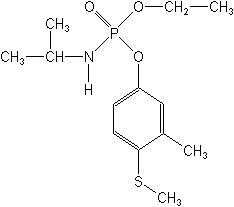-
Common NameFenamiphos
-
中文通用名苯线磷
-
IUPAC(RS)-(ethyl 4-methylthio-m-tolyl isopropylphosphoramidate)
-
CASethyl 3-methyl-4-(methylthio)phenyl (1-methylethyl)phosphoramidate
-
CAS No.22224-92-6
-
Molecular FormulaC13H22NO3PS
-
Molecular Structure
-
Category
-
ActivityNematicide
-
PremixEmulsifiable concentrate, granule, oil-in-water emulsion.
Premix Parters: captan;
-
Physical PropertiesMolecular weight:303.4; Physical form:Colourless crystals; ( tech., tan, waxy solid). Density:1.191 (23 °C); Melting point:49.2 °C; ( tech., 46 °C); Flash point:c. 200 °C; Vapour pressure:0.12 mPa (20 °C); 4.8 mPa (50 °C); Henry constant:9.1 × 10-5 Pa m3 mol-1 (20 °C); Partition coefficient(n-octanol and water):logP = 3.30 (20 °C); Solubility:In water 0.4 g/l (20 °C). In dichloromethane, isopropanol, toluene >200, hexane 10-20 (all in g/l, 20 °C).; Stability:Hydrolysis DT50 1 y ( pH 4), 8 y ( pH 7), 3 y ( pH< 9) (22 °C).;
-
ToxicologyOral:Acute oral LD50 for male and female rats c. 6, mice, dogs and cats c. 10 mg/ kg. Percutaneous:Acute percutaneous LD50 for rats c. 80 mg/kg. Slightly irritant to skin and eyes (rabbits). Inhalation: LC50 (4 h) for rats c. 0.12 mg/l air (aerosol). Phytotoxicity:Non-phytotoxic when applied to the soil.
-
Environmental ProfileEcotoxicology:
Algae: ErC50 for Scenedesmus subspicatus 11 mg/l.Birds:Acute oral LD50 for bobwhite quail 0.7-1.6, mallard ducks 0.9-1.2 mg/kg. Dietary LC50 (5 d) for mallard ducks 316, bobwhite quail 38 mg/ kg diet.Daphnia: LC50 (48 h) 0.0019 mg/l.Fish: LC50 (96 h) for bluegill sunfish 0.0096, rainbow trout 0.0721 mg/l.Worms: LC50 for Eisenia foetida 795 mg/ kg dry soil (400 EC).
Environmental fate:
Animals:In mammals, following oral administration, there is rapid metabolism involving oxidation to the sulfoxide and sulfone analogues, followed by subsequent hydrolysis, conjugation and excretion via the urine; some N-dealkylation also occurs (T. B. WaSoil:No effect on soil bacteria. Readily degradable in water, degradable on soil surfaces. Duration of activity in soil is c. 4 months. Based on Koc values and leaching studies, fenamiphos can be classified as a compound wiPlant:Degradation is by thiooxidation and hydrolysis. The major metabolites are fenamiphos sulfoxide and fenamiphos sulfone ( idem, ibid.). -
Transport InformationHazard Class:Ia(Extremely hazardous)
Porduct NewsMore
EU not to renew benalaxyl and fenamiphos
Australia Cancelled Registration of Fenamiphos Product from Pacific Agriscience

 0
0 Subscribe
Subscribe
